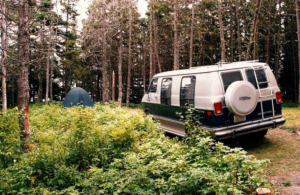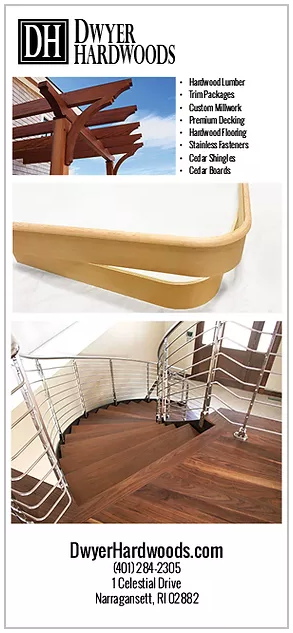I’ve got a damn bus to build, so let’s not muck about and get right to it…
No. 6 – PRICE. Every traditional camper van was approximately $9 million at the height of the times we were looking, on the back half of COVID. Kayaks were impossible to find the year before. We were fans of the RoadTrek brand in the late 90s, but they were always – and still are – prohibitively expensive, even the antique ones. I’ve always been a mega fan of 1980s/90s VW Westfalias, but they’ve never been reasonable and the platform was too small.

This is Gloria. She was a 1984 B-250 Conversion Van that ran like a dream and carried us all over Nova Scotia and beyond. Here, we’re in the Bay of Fundy, circa 1999.
So we settled for Gloria (named after the hurricane), a near-antique 1984 Dodge B-250 Explorer low-top conversion van, complete with fold-down bed, four captain’s chairs, a self-draining cooler/bar, roof rack, ladder, and velour for days. This was pre-pupper, but we bought that to circumnavigate Nova Scotia, via the northerly reaches of Maine, which was an awesome, awesome trip. We stayed exclusively at Provincial Parks, their equivalent of our State Parks, which really weren’t equivalent (those Canadians know how to take the ‘rust’ out of rustic). Even though we technically could do a camper van now, they would be kinda tight with two puppers and an X-Large me.
No. 5 – LOGISTICS. Tow-behind campers that were big enough for me, m’Lady, and m’two pups, were too big for my aging Xterra, which technically does have a towing capacity of 5k+, with my mods, but I really didn’t want to push it that much. Since this is my overlanding rig and winter daily, I didn’t want to fully kill it, especially now that it’s officially eligible for ‘Classic Car’ plates in CT. Sally does lack a bit in power, but does have plenty of torque (she once pulled a GMC Topkick off the highway, which just happened to be towing a construction trailer that was hauling my rally car).
New tow-behinds were all crazy-pricey as well, a lot of money for something that was kinda really made out of strong cardboard, at least the ones in our ‘reach’ price range. There were plenty of older ones out there, but most weren’t quite old enough to be kitschy enough as our ’73 Starcraft StarFlite 6 pop-up camper that we restored, used for several years, then sold to pursue our latest interests.
No. 4 – PRICE AGAIN. New Class A/B/C RVs are astronomically out of our price range, with most being almost as much as a nice house at the time. Side note, whilst Steph could probably live in an RV, this fella needs his space, a home base, and a place for all my other wacky hobbies.
Also at the time, kinda like kayaks the year before, new RV lots were basically empty. As soon as used ones came in, they were bought before they even had a chance to Febreze out the previous owner’s bachelor weekend.
So, too much moolah.
No. 3 – FUNK. We’re a creative team and like to think of different ways to get stuff done, particularly when it comes to having fun. So Steph and I thought that maybe buying that older Class A or C would be a great idea, budgeting in time and money for a restoration. We knew we wanted something funky and what better way to do that then buy and old Escape to Witch Mountain Class C Winnebago, or a funked-out Class A Dodge Travco.
On the latter, we found a Travco for super cheap. We looked it over online for days, coming back to it every now and then. It ‘ran when parked’, had zero functioning anything, but dang, it was cool! We even went so far as to ballpark budget a re-build, estimating 20 percent over as well, but when we found out that each side of the 2-piece windshield cost $1,200 (yep, that’s $2,400 totes), we regrettably bowed out of that dream. All it would have taken is a pebble from a Peterbilt on a gravel run to make a weekend at a KOA turn into missed mortgage payment.
No. 2 – CHEAP. Relative cheapness, that is, if you can even call it such a thing. Skoolies, like rally cars, are seductive in the sense that hey, you can go out and buy any old street car and build into a full-fledged rally car without dropping down Formula 1 money. But the trick maybe no one tells you about is that the car, or in this case, the bus, is actually the cheapest part of the build. It’s all the gubbins, time, and paychecks that go into it that starts making one think that a nice cushy bed in an asylum is probably the saner alternative. It’s sort of like the tiny house situation too. Sure, you can build a great tiny house for $15k, but not too many people tell you about the $75,000 truck you have to buy to get it through the Rockies.
That said, even if you double your skoolie budget, chances are, you’re still going to be in the money compared to buying a new, or near-new RV from a dealer. The advantage of a skoolie build is you can do it over time, there are no payments, and if you run out of money that month, you can do research and build stuff, or scrape stuff, wire stuff, etc., while you’re waiting for the piggy bank to start refilling.
No. 1 – FLAIR. Sorta like that Applebee’s-esque guy in Office Space, one of the main reasons we bought a skoolie was the ability to completely custom-fab everything we wanted in a weekend/road-trip cruiser. We’re also building Sunny to be like the Swiss Army Knife of skoolies in that we intend to use her for three main pruposes: The mobile division of Steph’s worksite wellness business, Integrative Health Services, where she’ll use the bus to hold on-site mindful meditation services and classes; a rally tow rig and mobile hotel; and, of course, a wicked cool RV for the fam to jump in and cruise off into the adventures with friends and other weirdos we meet along the way.
BONUS REASON: We chose a gas-powered mini skoolie for several reasons. Full-size skoolies are often cheaper than the short ones, but some have difficulty getting into state and national parks, and some regular campgrounds. Big skoolies and diesels, though more torquey and largely bullet-proof (I wanted that coveted 7.3 liter), but they are LOUD and a wee bit smelly (at the time of this post too, diesel is about $6.19/gallon – but they do get better mileage). Plus, the shortie, or mini skoolie, fits in a regular-size parking space and is quite maneuverable and easy-to-drive as a large van.
That’s it. Those are the main reasons we picked a skoolie over anything else. So if you’re thinking about taking the plunge, feel free to take a look around the site, and let us know what happens when you settle on a travel rig. Cheers!

